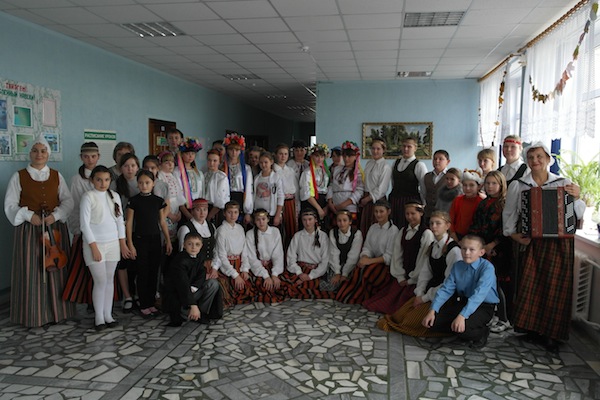In recent years the dominant discourse about the critical demographics in Latvia has been shrilly pessimistic. We’re told that the population has dropped in twenty years to two million. Emigration has reached catastrophic levels: the young seek their fortune elsewhere, never to return.
The UN and other organizations predict that in 20-30 years Latvia’s population will be 1.8 million, emptying Latvia and limiting its economic development. Employers are already complaining about labor shortages. This will mean the end of the Latvian state and Latvian extinction as a people. What solution is offered for this demographic and economic disaster? Since Western workers will not come, “empty” Latvia ought to be filled with migrant workers from the East.
This is the geographic view of Latvia’s demographic state. It looks at the territory of Latvia and its structures as tools for moneyed interests. The geographic vision does not disclose how labor migration will be achieved. However, this vision is not the only way to interpret demographic data and future predictions.
Historically, the population of Latvia has depended on its rulers, increasing under the Czarist and Soviet empires while decreasing under independence. In 1897 the population was 1.9 (million), in 1913- 2.5MM, 1920-1.5 MM, 1940-2 MM, 1990-2.7MM and in 2013 again 2 million. The twentieth century has been unkind to Latvians. They suffered three major losses: during the First World War – the Tsar’s edict evacuated Kurzeme and Zemgale with only about half returning to Latvia; the Second World War – flight to exile in the West; and Stalin’s deportations, from which few returned. The overall loss is over half a million. Including the unborn, Latvia’s loss is enormous. All losses can be attributed to the policies of the two empires.
In today’s globalized world, migration is fluid. Latvians, like others, emigrate, return, and re-emigrate. To assert that no one will return is absurd. In the five year period (2007 – 2012), 175 800 emigrated from Latvia, but 43 500 immigrated, almost exclusively returnees. The question is not whether emigrants will return, but rather how to improve conditions to lessen emigration.
There are two other demographic visions besides the geographical. The State vision, which evaluates demography from the perspective of the state and its citizens’ interests, and the folk or ethnic vision, which assesses demography based on ethnic interests.
In order of importance, the primary functions of the State are to protect national sovereignty, defend citizens’ interests and welfare. A state grants citizenship to foreign nationals if they legally reside there, are willing to defend the state, uphold its laws, and participate in or integrate into the host society. For security, the State is interested in minimizing hostile or harmful people in its environment. From a State’s perspective, population decline may not be an ‘emptying’, but rather normalization. If in 1996 72 % of the population were citizens and 27% non-citizens (nepilsoņi), in 2013 corresponding figures are 84 % and 13%. As the percentage of citizens significantly increases and the largest element of instability in the country, non-citizens, decreases by half, the State is more secure and less divided. Of the children born in 2000, 81% were citizens, 17% non-citizens, and 2% foreign nationals. In 2013, 93% of newborns are citizens, 5% non-citizens, and 2% foreign nationals, a sign State interests are changing for a better future.
The State is also interested in inclusion of its citizens living abroad. The recently revised Latvian citizenship law permits dual citizenship with friendly countries without loss of Latvian citizenship.
Normalization means that State structures, economics, and foreign policy are consistent with its size, national interests and geopolitical environment. To safeguard its sovereignty, Latvia joined the EU, NATO, and the Eurozone in 2014, and orientates towards the West, actions consistent with geopolitical realities and the long-term interests of its citizens. The economy is still limping, but since the recession a new crop of technologically advanced service and manufacturing companies have sprung up. These will form the base for future increases in population and well-being. The recent writing and addition of the preamble to the Constitution is part of Latvia’s normalization process.
The ethnic vision evaluates the survival skills and values of the nation: language, culture, and history. In tandem with the State vision, this vision is moving in a positive direction. The percentage of Latvians rose from 52% in 1990 to 62% in 2013. If in 1990 56.5% of births were ethnic Latvians and 43.5% others, in 2012 the proportions are 68% and 32%. Latvia’s birthrate therefore reflects the ethnic vision. In 2012 less than one percent of Latvians emigrated, while two and a half times more minorities emigrated. There have been three minority emigration peaks since 1990. The first in the mid-nineties with the evacuation of the Soviet Army, the second after Latvia joined the EU and the third after the 2008 economic crisis. Emigration has declined in the past three years.
Contrary to the geographical demographic interpretation, time is on the side of the state and ethnic interpretations. The ‘geographists’ know this, and have developed a scenario guaranteeing their interpretation’s success. This vision converges with Russia’s foreign policy and local moneyed interests. Although detaching Latvia from western institutions would be difficult, it could serve as Russia’s foreign policy ears and mouthpiece within the EU, NATO, the Eurozone and elsewhere. Local money sees a decreasing population and the Western direction of the country as impediments to their wealth acquisition. Moneyed Latvia consists of well-known Latvian oligarchs and the much richer and more influential Russian interests who understand and find the Eastern business environment more attractive than a Western one based on law and competition.
The geographic view scenario encourages emigration by introducing de facto bilingualism, citing economic reasons and needs of consumers, ignoring the Constitution and the results of the 2012 language referendum. It is almost impossible to find a job in Riga unless one also speaks Russian, and without it one must seek work abroad. The alarm raised about Latvia ‘emptying’ accustoms society to the thought that immigration from the east is necessary and inevitable.
The residence permit program (RP) was initiated by Ainārs Šlesers in 2010. Nearly all permits requested, however, are from CIS (Russian organised “Commonwealth of Independent States”) citizens, 80 to 90 % from Russia. For a small fee, Latvia offers the benefit of an RP enabling the right to visa-free entry into the EU. Other countries offer similar permits, but for a higher price and on more favorable terms to the issuing country. It’s claimed that between six to eight thousand such permits have been issued on 500Ls million investments. The number of RPs is secondary to the size of the investment. Inevitably the money will turn into political power. Latvia will lose control of the country’s political agenda, then over internal and external affairs, and eventually perhaps sovereignty.
To ensure Russian long-term geopolitical interests in Latvia and concurrently correct an “historical error”, the composition of the population can be changed by immigration. This will accelerate Latvian emigration and democratically transform Latvia forever. Latvia is highly dependent on Russian energy, and together with strong and organized foreign capital, resistance to Russian interests in Latvia would be academic.
Latvia must understand the gravity of the situation. It cannot fool itself that the “new money” will put Latvia on easy street. Allowing the geographists “emptying” scenario to unfold would be a crime against the Latvian state and nation. The other two visions retain future control of the Latvian state in its citizens’ hands. Latvians must think long and hard how to reverse the emigration of its citizens, promote their fertility, help the disaffected find happiness elsewhere in the world and act accordingly.





